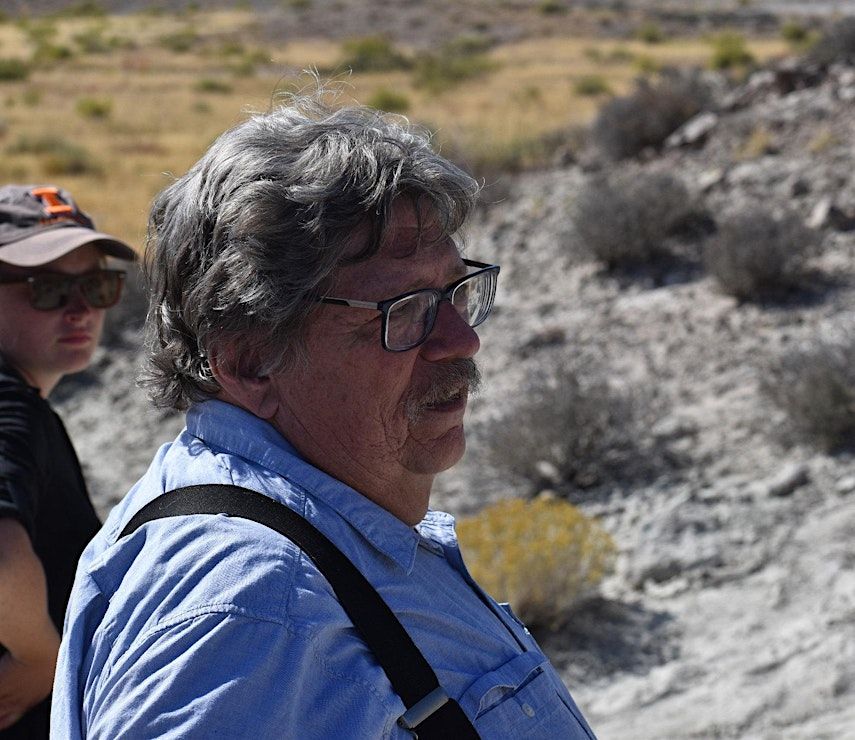How Fossil Soils Help Document the End of the Real Jurassic Park
Schedule
Thu Nov 13 2025 at 07:00 pm to 08:00 pm
UTC-07:00Location
Clark Planetarium | Salt Lake City, UT

About this Event
How fossil soils help document the end of the Real Jurassic Park
Closing the gap between the Jurassic and Cretaceous reveals a dinosaurian mass-extinction. Fossil soils indicate it may have been triggered by an asteroid impact--or by the largest shield volcano in our Solar System: the Shatsky Rise! Did an asteroid K*ll off Utah’s beloved Jurassic Park...or was it the formidable Shatsky Rise?
A Berriasian age (145–142 Ma) for the base of the lower Yellow Cat Member (YC) of the Cedar Mountain Formation (CM) in Utah is indicated by microfossils, chemostratigraphy, and U-Pb dating of paleosols, with the onset of deposition near the beginning of Cretaceous. Euroamerican Morrison “style” dinosaur faunas dominated by diverse sauropods (mostly diplodocids), stegosaurs, small to medium ornithopods, large theropods (ceratosaurs, megalosaurids, and allosaurids), and uncommon coelurosaurs persisted for the last 10 Ma of the Jurassic. By contrast, the first 25 Ma of the Early Cretaceous had Wealden “style” dinosaur faunas dominated by a low diversity of turiasaur and titanosauriform sauropods, polacanthid ankylosaurs, large ornithopods, large megalosauroid spinosaurids (exclusive to Europe), allosauroid carcharodontosaurid theropods, and an increased abundance of larger coelurosaurs reflecting a profound J-K dinosaur faunal turnover. The paleosol sequence at the base of the YC, laterally equivalent to the fluvial Buckhorn Conglomerate of the CM, consists of basal ferruginous paleosols (gleysols) overlain by silicified peat (histosols), which are then overlain by calcareous paleosols (vertisols and aridosols). A kaolinite bed (oxisol) has been identified at the J-K unconformity locally. Based on these paleosols, Utah’s earliest Cretaceous is characterized by an interval of unusually wet paleoclimates bracketed by drier paleoclimates during the Late Jurassic and remainder of the Early Cretaceous. Potential drivers close to the J-K boundary for this climatic excursion and faunal turnover include a mega-shield volcano(s) at Shatsky Rise in the western Pacific, and less significantly South Africa’s Morokweng impact. Was the Cretaceous bookmarked by asteroid impacts?
JIM KIRKLAND -- Jim Kirkland got Ph.D. at Univ. of Colorado; was formerly with Dinamation International Society (1989-1999) and has been a consultant for numerous documentaries and museum exhibits. Since 1999, he has been the State Paleontologist with the Utah Geological Survey. An expert on the Mesozoic, he has spent 51 years excavating fossils across the southwestern US and Mexico authoring and coauthoring more than 90 professional papers. The reconstruction of ancient environments, biostratigraphy, paleobiogeography, paleoecology, and mass extinctions are some of his interests. He has discovered and taken part in describing 23 new dinosaurs including 6 ankylosaurs; Mymoorapelta, Gastonia, Europelta, Animantarx, Alretopelta, & Cedarpelta (3 more in manuscript); a Cretaceous turiasaur sauropod, Mierasaurus; 7 ornithopods Eolambia, Coahuilasaurus, Velerofrons, Iguanocolossus, Hippodraco, Jeyawati, & Proa; 2 ceratopsians, Zuniceratops & Diabloceratops and 8 theropods Nedcolbertia, Falcarius, Geminiraptor, Martharaptor, Nothronychus, Yurgovuchia, Suskityrannos, and the giant “raptor” Utahraptor. He has described and named one mammal Cifelliodon, many fossil mollusks, fossil fish Morrolepis, Mylecrista, Pseudomyledaphis,..etc. and several stratigraphic units. His research into the lower and middle Cretaceous of Utah indicate that the last biogeographic connections to Europe were around 120 Ma and followed by 20 MA on an island continent, and utilizing Utah dinosaurs documented the origins of Alaska and the first great Asian-North American faunal interchange occurred at about 100 million years ago. Helped establish Utahraptor State Park. Documented how salt tectonics resulted not just in forming Arches Nat. Park, but in Grand County, Utah preserving the 2-5 of the oldest Cretaceous dinosaur faunas in North America.
This event is free and open to the public, but seating is limited. Please reserve only the number of tickets you will use.
About Science Utah:
The Science Utah Lecture Series is dedicated to bringing the latest scientific discoveries and discussions to the public, for free, by offering engaging lectures led by Utah-based scientists and researchers working in various fields.
To help support Clark Planetarium's efforts, please consider making a small donation at https://givebutter.com/ScienceUT. All donations aid Clark Planetarium and the free community events we offer year-round. Your contribution is invaluable in helping us inspire and educate people of all ages about the wonder of the universe.

Where is it happening?
Clark Planetarium, 110 South 400 West, Salt Lake City, United StatesEvent Location & Nearby Stays:
USD 0.00




















